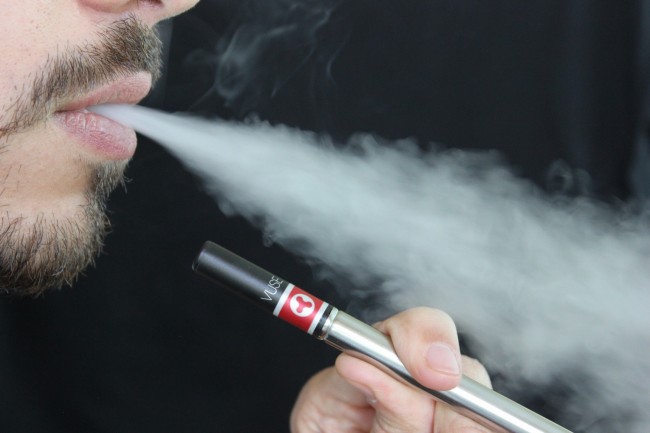E-Cigarette Online Stores in China Asked to Stop
By Staff Reporter | Nov 05, 2019 04:36 AM EST
 (Photo : Pixabay)
(Photo : Pixabay)
The People's Republic of China has called for the cease of sales and marketing of e-cigarettes and vaping equipment online which could practically result in a total ban on the use of such materials. This move was conceived by a joint idea of a Chinese regulator and the state tobacco monopoly stating not only health concerns but also the rise in e-cigarette users.
The vaping industry
China's e-cigarette and vaping industry has been booming for the past years. According to a study by Tsinghua University's Public Health and Technology Supervision Research Group, China has more than 7.4 million e-cigarette users. Furthermore, it is the largest producer of e-cigarette products.
On the other hand, Americans spend $7 billion in annual sales only for e-cigarettes and vaping. Aside from being commercially available in online platforms and being lured online by using terms such as "young" and "fashion", part of the market involves targeting teenagers with flavors such as Bazooka Joe Bubble Gum and Zombie Blood. These make it popular not only to minors but to elders as well. At an exposition in Shanghai this week, women in pencil dresses and heels gave out flavored liquids like Bulgarian rose, bubble tea, and Moutai, a Chinese liquorwhich makes it appealing to all age brackets.
However, not only Chinese and United States authorities have been rethinking of banning e-cigarettes and vapes but also authorities in India. Because of this, a statement was released.
Support from popular e-cigarette brands
Even with the "vaguely" worded announcementposted on the websites of the State Administration of Markets and the State Tobacco Monopoly Administration, three online platforms quickly removed their ads related and regarding to e-cigarettes and vaping devices. Additionally, seven of China's popular brands, headed by RELX, posted statements on their social media accounts that they will act on terminating the sales and advertisement of such devices on the internet. However, the biggest e-commerce platforms such as JD.com and Alibaba did not leave any comment.
Mysterious vaping-related lung injuries
Moreover, the increasing concern towards the number of mysterious vaping-related lung injuries is one of the reasons behind the ban. The death of John Steffen, 68, from Nebraska, made headlines across the state after dying with vaping-related illness instead of dying from respiratory failure and pulmonary disease after years of smoking cigarettes.
The general knowledge is that smoking via cigarettes would cause lung cancer and so it was the use of e-cigarettes that convinced Mr. Steffen to change his mind. According to Mrs. Steffen, Mr. Steffen began vaping five years ago using nicotine—e-cigarette brands like Mistic, blu, and Juul, all of which are sold over the counter at drugstores. According to representatives on mentioned brands, they said that they "appreciate the work of the Centers for Disease Control (CDC), Food and Drug Administration (FDA), and the state public health authorities."
Unfortunately, Dr. Thomas Safranek, the state epidemiologist, admitted that if the department of health didn't receive a tip, they wouldn't know that Mr. Steffan's death was tied to vaping.
Moreover, although the investigators didn't have a conclusion as of yet, they seem to link the illness to appear to people who have used tetrahydrocannabinol (THC)- or cannabidiol (CBD)- related products
By Staff Reporter | Nov 05, 2019 04:36 AM EST

The People's Republic of China has called for the cease of sales and marketing of e-cigarettes and vaping equipment online which could practically result in a total ban on the use of such materials. This move was conceived by a joint idea of a Chinese regulator and the state tobacco monopoly stating not only health concerns but also the rise in e-cigarette users.
The vaping industry
China's e-cigarette and vaping industry has been booming for the past years. According to a study by Tsinghua University's Public Health and Technology Supervision Research Group, China has more than 7.4 million e-cigarette users. Furthermore, it is the largest producer of e-cigarette products.
On the other hand, Americans spend $7 billion in annual sales only for e-cigarettes and vaping. Aside from being commercially available in online platforms and being lured online by using terms such as "young" and "fashion", part of the market involves targeting teenagers with flavors such as Bazooka Joe Bubble Gum and Zombie Blood. These make it popular not only to minors but to elders as well. At an exposition in Shanghai this week, women in pencil dresses and heels gave out flavored liquids like Bulgarian rose, bubble tea, and Moutai, a Chinese liquorwhich makes it appealing to all age brackets.
However, not only Chinese and United States authorities have been rethinking of banning e-cigarettes and vapes but also authorities in India. Because of this, a statement was released.
Support from popular e-cigarette brands
Even with the "vaguely" worded announcementposted on the websites of the State Administration of Markets and the State Tobacco Monopoly Administration, three online platforms quickly removed their ads related and regarding to e-cigarettes and vaping devices. Additionally, seven of China's popular brands, headed by RELX, posted statements on their social media accounts that they will act on terminating the sales and advertisement of such devices on the internet. However, the biggest e-commerce platforms such as JD.com and Alibaba did not leave any comment.
Mysterious vaping-related lung injuries
Moreover, the increasing concern towards the number of mysterious vaping-related lung injuries is one of the reasons behind the ban. The death of John Steffen, 68, from Nebraska, made headlines across the state after dying with vaping-related illness instead of dying from respiratory failure and pulmonary disease after years of smoking cigarettes.
The general knowledge is that smoking via cigarettes would cause lung cancer and so it was the use of e-cigarettes that convinced Mr. Steffen to change his mind. According to Mrs. Steffen, Mr. Steffen began vaping five years ago using nicotine—e-cigarette brands like Mistic, blu, and Juul, all of which are sold over the counter at drugstores. According to representatives on mentioned brands, they said that they "appreciate the work of the Centers for Disease Control (CDC), Food and Drug Administration (FDA), and the state public health authorities."
Unfortunately, Dr. Thomas Safranek, the state epidemiologist, admitted that if the department of health didn't receive a tip, they wouldn't know that Mr. Steffan's death was tied to vaping.
Moreover, although the investigators didn't have a conclusion as of yet, they seem to link the illness to appear to people who have used tetrahydrocannabinol (THC)- or cannabidiol (CBD)- related products


